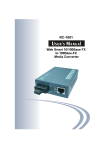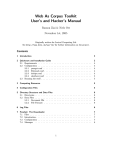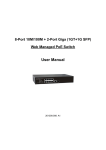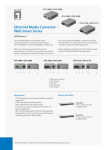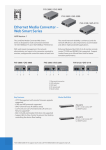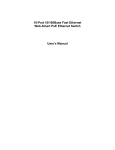Download LevelOne FVS-3200 network media converter
Transcript
Ethernet Media Converter Web Smart Series User Manual v1.0 May. 2011 i Ethernet Media Converter Web Smart Series FVS-3800, 10/100BASE-TX to 100BASE-X SFP Converter FVS-3200, 10/100BASE-TX to 100BASE-FX MMF SC Converter FVS-3120, 10/100BASE-TX to 100BASE-LX SMF SC Converter GVS-3800, 10/100/1000BASE-T to 1000BASE-X SFP Converter GVS-3200, 10/100/1000BASE-T to 1000BASE-SX MMF SC Converter GVS-3110, 10/100/1000BASE-T to 1000BASE-LX10 SMF SC Converter CVH-3000, 12-Slot Media Converter Chassis i Table of Contents CAUTION.......................................................................................................................................... III ELECTRONIC EMISSION NOTICES.................................................................................................... III 1. INTRODUCTION ............................................................................................................ 2 1-1. OVERVIEW .................................................................................................................................. 2 1-2. FEATURES ................................................................................................................................... 2 1-3. CHECKLIST ................................................................................................................................. 3 2. INSTALLATION .............................................................................................................. 5 2-1. CABLE AND HARDWARE INSTALLATION (WEB SMART MEDIA CONVERTERS) .......................... 5 2-2. CABLE AND HARDWARE INSTALLATION (WEB SMART MEDIA CONVERTER CHASSIS) ............. 5 3. OPERATION OF WEB-BASED MANAGEMENT ...................................................... 8 3-1. WEB MANAGEMENT HOME OVERVIEW ..................................................................................... 9 3-2. THE FUNCTION TREE IN WEB MANAGEMENT.......................................................................... 11 3-3. LOCAL SETTING ....................................................................................................................... 12 3-3-1. IP Configuration ............................................................................................................ 12 3-3-2. Password Setting ............................................................................................................ 14 3-3-3. Converter Configuration ............................................................................................... 15 3-3-4. Port Configuration......................................................................................................... 17 3-3-5. MIB Counter .................................................................................................................. 19 3-3-6. VLAN .............................................................................................................................. 20 3-3-6-1. VLAN Group ........................................................................................................................... 20 3-3-6-2. VLAN Per Port Setting ........................................................................................................... 22 3-3-7. Q-in-Q ............................................................................................................................. 23 3-4. Remote Setting.................................................................................................................... 29 3-4-1. TS-1000 Functions ......................................................................................................... 29 3-4-1-1. TS-1000 Setting ....................................................................................................................... 29 3-4-1-2. Loopback Test ......................................................................................................................... 31 3-4-1-3. Remote Device Reset ............................................................................................................... 32 3-4-1-4. Remote Port Information ....................................................................................................... 33 3-4-1-5. Remote Port Setting ................................................................................................................ 33 3-4-2. 802.3ah Function ............................................................................................................ 34 3-4-2-1. 802.3ah Configuration ............................................................................................................ 34 3-4-2-2. Loopback Test ......................................................................................................................... 35 3-4-2-3. 802.3ah Status.......................................................................................................................... 36 3-5. TOOLS....................................................................................................................................... 37 3-5-1. System Reboot ................................................................................................................ 37 3-5-2. Save and Restore ............................................................................................................ 38 3-5-3. Firmware Upgrade ........................................................................................................ 39 3-5-4. Logout ............................................................................................................................. 39 4. MAINTENANCE.............................................................................................................40 4-1. RESOLVING NO LINK CONDITIONS........................................................................................... 40 4-2. Q&A ........................................................................................................................................ 40 APPENDIX A TECHNICAL SPECIFICATIONS ...........................................................41 ii Caution Circuit devices are sensitive to static electricity, which can damage their delicate electronics. Dry weather conditions or walking across a carpeted floor may cause you to acquire a static electrical charge. To protect your device, always: • Touch the metal chassis of your computer to ground the static electrical charge before you pick up the circuit device. • Pick up the device by holding it on the left and right edges only. Electronic Emission Notices Federal Communications Commission (FCC) Statement This equipment has been tested and found to comply with the limits for a class A computing device pursuant to Subpart J of part 15 of FCC Rules, which are designed to provide reasonable protection against such interference when operated in a commercial environment. European Community (CE) Electromagnetic Compatibility Directive This equipment has been tested and found to comply with the protection requirements of European Emission Standard EN55022/EN60555-2 and the Generic European Immunity Standard EN50082-1. EMC: EN55022(1988) /CISPR-22(1985) EN60555-2(1995) EN60555-3 IEC1000-4-2(1995) IEC1000-4-3(1995) IEC1000-4-4(1995) class A class A 4K V CD, 8KV, AD 3V/m 1KV – (power line), 0.5KV – (signal line) About this user’s manual In this user’s manual, it will not only tell you how to install and connect your network system but configure and monitor the Web Smart MEDIA CONVERTER through the built-in web by Ethernet ports step-by-step. Many explanations in detail of hardware and software functions are shown as well as the examples of the operation for webbased interface. Overview of this user’s manual Chapter 1 “Introduction” describes the features of Web Smart MEDIA CONVERTER Chapter 2 “Installation” Chapter 3 “Operation of Web-based Management” Chapter 4 “Maintenance” Appendix A 1 1. Introduction 1-1. Overview The LevelOne Media Converter-Web Smart Series is designed to make conversion between 10/100Base-TX and 100Base-FX or 10/100/1000Base-TX and 100/1000Base-FX Ethernet. With web-based management and Telnet text-based manual driven management, the network administrator can logon the remotely converter to monitor, configure and control the status of each unit. The overall network reliability is enhanced, and the network efficiency is also improved to accommodate and deliver high bandwidth applications. The 19-inch Media Converter Rack, CVH-3000, is designed to accommodate 12 units of various type of web smart media converter at a central location for multiple segments cross connection. DC −48V power supply is used and provided by Telecom site. The Rack provides solutions for users to best manage media converters. Since converter is connected directly to the chassis main-board, no power cable or wire is required for connection. Moreover, a redundant power supply is offered in the power supply set to cope with any accidental breakdown of power supply. 1-2. Features The Web Smart Media Converter provides the following features for users to perform system network administration. Management • Supports Web UI for management • Supports OAM for remote management via TS-1000 • Supports OAM for remote management via IEEE802.3ah • Supports Ingress/Egress Rate Limitation • Supports Link Loss Carry Forward Function • Supports per Port MIB Counters • Supports IEEE802.1Q VLAN • Supports Q-in-Q (Double-Tag) VLAN • Supports 802.3x flow control for full-duplex ports and backpressure for half-duplex ports • Supports auto mode on the TP port • Supports jumbo frame 9KB • RoHS Compliance • On-board firmware can be updated via HTTP web function. • The converter allows administrator to reboot system from management station. • Dying Gasp function can send out a signal when DC power down is detected. 2 1-3. Checklist Before you start installing the converter, please verify that the package contains the following: Web Smart Media Converters: Web Smart Media Converter AC-DC Power adapter This User's Manual (CD) Web Smart Media Converters Chassis: The Media Converter Rack Mounting Accessory (for 19" Rack Shelf) and Rubber feet (if not using Rack Shelf) This User's Manual AC Power Cord Please notify your sales representative immediately if any of the aforementioned items is missing or damaged. Model Description Model FVS-3800 FVS-3200 FVS-3120 GVS-3800 GVS-3200 GVS-3110 CVH-3000 Description 10/100BASE-TX to 100BASE-X SFP Converter 10/100BASE-TX to 100BASE-FX MMF SC Converter 10/100BASE-TX to 100BASE-LX SMF SC Converter 10/100/1000BASE-T to 1000BASE-X SFP Converter 10/100/1000BASE-T to 1000BASE-SX MMF SC Converter 10/100/1000BASE-T to 1000BASE-LX10 SMF SC Converter 12-Slot Media Converter Chassis 3 LED Indicators Description LED POWER FX LINK/ACT TP LINK/ACT TP 10/100 Color Function Green Lit when +5V power is coming up Lit when fiber connection is good Green Blinks when any traffic is present Lit when TP connection is good Green Blinks when any traffic is present Lit when 100Base-TX is active Amber Off when 10Base-T is active Table 1-1 Reset button: Press this button over 5 seconds then (1) Restore to default (2) Reboot 4 2. Installation 2-1. Cable and Hardware Installation (Web Smart Media Converters) ⇒ Wear a grounding device for electrostatic discharge ⇒ Verify that the AC-DC adapter conforms to your country AC power requirement and then insert the power plug • TP Cable ⇒ Use Cat. 5 TP cable to connect server/host or workstation to TP port of the converter ⇒ TP port supports MDI/MDI-X auto-crossover, use: straight-through cable (Cable pin-outs for RJ-45 jack 1, 2, 3, 6 to 1, 2, 3, 6) to cascade or up-link the converter to an upper layer L2/L3 switch or server/host/workstation ⇒ TP Cable Limitations: Cat. 5 and up to 100m • Fiber Cable ⇒ Use fiber cable to connect FX port of an upper layer converter ⇒ Fiber Cable Limitations: SC Converter Models Multi-mode Half-duplex 412m Multi-mode Full-duplex 2Km Single-mode Half-duplex 412m Single-mode Full-duplex 10/30/50Km Table 2-1 Note: The other side of the fiber cable plugged into the converter’s RX connector at the near end should plug into the FX device’s TX connector at the far end, and vice versa. 2-2. Cable and Hardware Installation (Web Smart Media Converter Chassis) 2.5mm DC Receptacle 2.5mm 1A@+5V for each slot DC receptacle is 2.5mm wide that matches and conforms to the Media Converter 2.5mm DC jack's central post. Do not install any improper unit or model of the Media Converter. ⇒ The slide-in Media Converters and Converter Rack should be supplied only from the same source; both Media Converters and Rack are built to match each other at dimensions, DC power jack, DC receptacle and power safety. ⇒ Turn off the 19" converter rack power. ⇒ Verify the Media Converter is right for this Rack and locate +5VDC power jack on converter back, and carefully slide in and plug to match 19" rack slot +5VDC receptacle. 5 Fig. 1 Front/Rear View of 19-inch Fig. 2 The hot-swappable parts Fig. 3 Installing Rack Fig. 4 Usage of 8cm FAN connector 6 Installing Media Converter Rack to a Wiring Closet Rack ⇒ ⇒ ⇒ ⇒ ⇒ Wear a grounding device for electrostatic discharge Install screws through mounting ears into each side Locate Converter Rack at 19-inch mounting rails and screw up the front brackets Set the Power Switch at "OFF" position before connecting with the power cord Two power modules, 12 converter modules and two 8cm DC Fans are Hot-Swappable 7 3. Operation of Web-based Management The converter provides a web function by Ethernet Port (Browser) to manage and monitor the port activity. For instance, http://192.168.1.1, then enter password and CLICK “Login” button. The default values of Web Smart Media Converter are as follows: IP Address :192.168.1.1 Subnet Mask :255.255.255.0 Default Gateway :192.168.1.254 Password :admin Fig. 3-1 8 3-1. Web Management Home Overview Home Page and Main MENU will be shown up after you fill in “admin” to serve as password and click the <Login> button. The main functions will be listed on the left side of a browser. On the top is the front panel view of the converter. In the middle is the basic System Information. The main functions will be introduced in the following sections. On the front panel, the LEDs will display the status color which is the same as physical hardware. The fiber and TP plug will display the status color as well. Green stands for “Link up” status. The main functions are “Information”, “Local Setting”, “Remote Setting”, and “Tools”. Function name: System Information Function description: Show the local and remote device network information. Fig. 3-2 Parameter description: Remote Device Control: Disable (Default): When Remote Device Control is disabled, the remote device information will not be shown on the screen. Enable: When Remote Device Control is enabled, the remote device information will be shown on the screen. MAC address: It is the Ethernet MAC address of the management agent in this device. 9 Software Version: It’s a firmware version of this device. IP address/Gateway/Subnet Mask: It’s an IP address of the device. Default Setting: IP Address: 192.168.1.1 Default Gateway: 192.168.1.254 Subnet Mask: 255.255.255.0 Description: It is a field for model description. Serial number: It is a product serial number. Hardware Version: It is a hardware version of product. 10 3-2. The Function Tree in Web Management For offering you a clear guide to use this Web Smart Media Converter, the following is the whole function tree of Web Smart Media Converter in web management. User can refer to the following sections based on the order of this function tree below for more details. Fig. 3-3 11 3-3. Local Setting Fig. 3-4 3-3-1. IP Configuration IP configuration is one of the most important configurations in WEB SMART MEDIA CONVERTER. Without the proper setting, network manager will not be able to view the device. WEB SMART MEDIA CONVERTER supports both manual IP address setting and automatic IP address setting via DHCP server. When IP address is changed, you must reboot the converter to have the setting taken effect and use the new IP to browse for web management. Function name: IP Configuration Function description: Set IP address, subnet mask and default gateway for WEB SMART MEDIA CONVERTER. Fig. 3-5 IP Configuration 12 Parameter description: DHCP Client: WEB SMART MEDIA CONVERTER supports DHCP client used to get an IP address automatically if you set this function “Enable”. WEB SMART MEDIA CONVERTER will find the DHCP server existed in the network to get an IP address. If this function is set “Disable”, you have to input IP address manually. Default: Disable IP address: Users can configure the IP settings and fill in new values if users set the DHCP function “Disable”. Then, click <Apply> button to update it. Default: 192.168.1.1 Subnet mask: Set the subnet mask value which is the same as that of network it attaches. For more information, please also see the section “IP Address Assignment” in this manual. Default: 255.255.255.0 Default gateway: Set an IP address for a gateway to handle those packets that do not meet the rules predefined in a device. If a packet does not meet the criteria for other routers, then it must be sent to a default router. This means any packet with undefined TCP/IP information will be sent to this device unconditionally. Default: 192.168.1.254 Description: Input data or model name about this device then click <Apply> button. 13 3-3-2. Password Setting Function name: Password Setting Function description: The default user account is “admin” that can not be modified or deleted and is the only one user account. The password must be ‘a’-‘z’, ‘A’-‘Z’, ‘0’-‘9’ and ‘_’. The max. length is 16 characters. After input the data as Fig. 3-6 click <Apply> button. The default setting of user account is: Username: admin Password: admin Fig. 3-6 Parameter description: Login Name: admin (can not be modified) Old Password: Input the old password New Password: Input new password Confirm: Input the new password again 14 3-3-3. Converter Configuration Function name: Converter Configuration Function description: This converter provides the following configurable parameters. Fig. 3-7 Converter Configuration Parameter description: Jumbo Frame(9K): If enable this function, the media converter could pass the max. 9KB packets. Link Transparent: Only if link transparent is enabled, the Remote Fault Detect and Link Loss Carry Forward will take effect. Remote Fault Detect: If enable this function, when fiber port enable TS-1000 and receive OAM packet. This converter will set local UTP port link up or link down 15 according to remote device’s UTP port link status. This function need enable link transparent first. Link Loss Carry Forward: If enable this function, when the UTP port link down, the fiber port will be forced link down. And the fiber will be resume when UTP port link up. This function need enable link transparent first. Notice: If local MC (Media Converter) enables TS1000 and is configured as Center Mode, when configuring Jumbo Frame and Link Transparent functions for local MC, the remote MC will be configured at the same time even if it is a dump MC. And the configuration of remote side is the same as local side. Forward CRC Error Frame: If enable this function, the CRC error packet will be pass, otherwise, the CRC error packets will be dropped. Forward Pause Frame: If this function was enabled, this MC will forward pause frame and regard it as a normal packet. Management Packet High Priority: If enable this function, this MC will enable QOS. We enable four queues, and set queue 3 as strict priority. All management packets, such as 802.3ah OAM packets will be in queue 3 to guarantee bandwidth. Broadcast Storm Filter, Multicast Storm Filter, Unknown DA Unicast Storm Filter: If enable this function, when too many broadcast/multicast/unknown DA unicast packets arrive in a period time, the packets will be dropped. 16 3-3-4. Port Configuration Function name: Port Configuration Function description: Change the state and configuration of each port. This page could set local device’s port status, include work mode, flow control ability, ingress and egress rate limit. Fig. 3-8 Port Configuration Parameter description: Port: The TP Port is MEDIA CONVERTER’s Ethernet UTP interface. The FX Port is MEDIA CONVERTER’s Ethernet Fiber interface. Link: Show port current link status: 100F = Speed 100M, Full Duplex Mode 100H = Speed 100M, Half Duplex Mode 10F = Speed 10M, Full Duplex Mode 10H = Speed 10M, Half Duplex Mode Down = Link Down Mode: The Auto Speed algorithm to exchange the capability with the linked partner. When enabled, the speed, duplex mode and flow control mode may change. You must have both port configuration of local port and linked partner be the same. If their configuration is different, the link will not be set up successfully. In WEB SMART MEDIA CONVERTER, fiber port supports forced mode only. Set the mode of speed and duplex. In speed, 10/100Mbps baud rate is 17 available for Fast Ethernet. If the media is fiber, it is always 100Mbps and the duplex is 100full/auto; if the media is TP, the Speed/Duplex is comprised of the combination of speed mode, 10/100Mbps, and duplex mode, full duplex and half duplex. Flow Control: There are two modes to choose in flow control, Enable and Disable. If flow control is set “Enable”, both parties can send PAUSE frame to the transmitting device(s) while the receiving port is too busy to handle. When it is set “Disable”, flow control will not exist in the port. It drops the packet if too much to handle. Default: Enable Ingress Rate Limit and Egress Rate Limit: There are some predefined rate settings. If user needs some special usage, you could input the rate by yourself after “User Setting” has been selected from pull down list. Because the rate limit is 64kbps as a minimal step, the input rate limit, it should be divided exactly by 64. If the rate value can not be divided exactly by 64, for example 65, the program will be change the rate to 64 automatically. Default: Not Limit 18 3-3-5. MIB Counter Function name: MIB Counter Function description: The page shows local device’s MIB counters. If click the “clear” button, all MIB counters will be clear to zero. Click the“refresh” button, show the current MIB counters again. Fig. 3-9 19 3-3-6. VLAN The Converter supports Tag-based VLAN (802.1Q). VLAN configuration is used to partition your LAN into small ones as your demand. Properly configuring it, you can gain not only improving security and increasing performance but greatly reducing VLAN management. 3-3-6-1. VLAN Group Function name: 802.1Q VLAN Group Function description: If enable VLAN functions, user could set 16 VLAN entries. Each VLAN entry could set VID and member port. The VID should be 1~4094.Others when the member port is evoked, this port will belongs to this VLAN group. Notes and Scenaro: VLAN Group 2 (VID: 2): TP, FX, CPU are members of this VLAN group. It’s meaning that some Pkts (with tag 2) go into this converter; the Pkts can forward to TP, FX, and CPU. Another case: Vlan Group 3 (VID 3): TP, CPU are members of this VLAN group, So Pkts (with tag 3) go into this converter, the Pkts can forward to TP and CPU only. Fig. 3-10 20 Parameter description: VLAN Group: To display the VLAN Group Index. The maximum is 16 and the range is from 0 to 15. VID: VLAN identifier. Each tag-based VLAN group has a unique VID. It appears only in tag-based and Double-tag mode. TP: To evoke the TP (The converter’s UTP port) to become a VLAN group member. FX: To evoke the FX (The converter’s Fiber port) to become a VLAN group member. CPU: To evoke the CPU (The converter’s CPU) to become a VLAN group member. It means that CPU needs to become a VLAN member for management purpose. 21 3-3-6-2. VLAN Per Port Setting Function name: 802.1Q VLAN Per Port Setting Function description: In this page, we could set each port’s PVID and egress tag behavior. Fig. 3-11 Parameter description: Egress Link Type: Replace Tag: The switch will remove VLAN tags from packets then add new tags to them. The inserted tag is the ingress port’s “Default tag”, which is indexed by port “Port based VLAN index ”. This is a replacement processing for tagged packets and an insertion for untagged packets. Remove Tag: The switch will remove VLAN tags from packets, if they are tagged when these packets are output. The switch will not modify packets received without tags. AddTag: The switch will add VLAN tags to packets, if they are not tagged when these packets are output on this port. The switch will not add tags to packets already tagged. The inserted tag is the ingress port’s Default tag, which is indexed by port’s “Port based VLAN index”. Don’t Touch Tag: Do not insert or remove VLAN tags to/from packet which is output on this port. Port VLAN Entry: Select Port based VLAN index. The number means VLAN table entry index, not VID. 22 Ingress Filter: Enable or Disable VLAN ingress filter. Application 1 description: Example for Replace Vlan description: Topology: Converter A Converter B Fig. 3-11-1 Application 1 Scenario explain: Switch A VLAN setting: Port 1 ~ 4: members of VLAN 2 group (PVID: 2) Port 1 is trunk mode, port 2~4 is access mode. Switch B VLAN setting: Port 5 ~ 8: members of VLAN 10 group (PVID: 10) Port 5 is trunk mode .port 6~8 is access mode. Purpose: Client A & B can communicate with each other (and don’t changed original setting on Switch A & B) How to setting on Converter A & B? Step1. Pls add VLAN 2 & 10 entry on the table, and confirm port members are selected. (The same VLAN group setting on Converter A & B) 23 Fig. 3-11-2 Step2. Converter A VLAN per port setting: Fig. 3-11-3 Step3. Converter B VLAN per port setting: Fig. 3-11-4 Finish this setting above, client A & B can communicate with each other; and do not need to change original VLAN setting. 24 Application 2 description (same VLAN) : Example Topology: Converter A Converter B Application 2 Scenario explain: Switch A VLAN setting: Port 1 ~ 4: members of VLAN 2 group (PVID: 2) Port 1 is trunk mode, port 2~4 is access mode. Switch B VLAN setting: Port 5 ~ 8: members of VLAN 2 group(PVID: 2) Port 5 is trunk mode .port 6~8 is access mode. Purpose: Client A & B can forwarding each other (and don’t changed original setting of Switch A & B) How to setting on Converter A & B? Step1. .Pls add VLAN 2 entry on the table, and confirm port members are selected. (The same VLAN group setting on Converter A & B) 25 Fig. 3-11-5 Step2. Converter A VLAN per port setting: Fig. 3-11-6 Step3. Converter B VLAN per port setting: Fig. 3-11-7 Finish this setting above, client A & B can forwarding each other; and don’t change original VLAN setting 26 3-3-7. Q-in-Q Function name: Q-in-Q Function description: This page could configure Q in Q function. Fig. 3-12 Fig. 3-13 27 Parameter description: Out Layer VLAN Tag: User defined Q-in-Q out layer VLAN tag Ether type. Out Layer VLAN VID: User defined Q-in-Q out layer VLAN tag VID VLAN Tag Priority Decision: Decide out layer VLAN Tag’s priority, use internal VLAN tag priority or use IP remarking priority. Q in Q direction: Select Q in Q direction, which port adds tag, and which port removes tag. “TP Port Add Q in Q Tag FX Port Remove Tag” or “FX Port Add Q in Q Tag TP Port Remove Tag”. 28 3-4. Remote Setting Fig. 3-14 3-4-1. TS-1000 Functions TS-1000 Functions include “TS1000 Setting”, “Loopback Test”, “Remote Device Reset”, “Remote Port Information”, “Remote Port Setting” five functions. 3-4-1-1. TS-1000 Setting Function name: TS-1000 Setting Function description: This page could enable/disable TS1000 function, and set TS-1000 mode as terminal or center. If TS1000 is enabled, the TS1000 information will be displayed in the web. And if it’s in center mode, and remote device is in terminal mode, remote TS1000 information will also be shown in the page. 29 Fig. 3-15 30 3-4-1-2. Loopback Test Function name: Loopback Test Function description: This page could start TS1000 loopback function. User could set TS1000 loopback packet number. After that click the <Apply> button, the loopback test result will be displayed in the web. Fig. 3-16 Parameter description: Send packet number: After input the number between 1 and 255, click the “<Apply>” button. Result: Pass or not as Fig. 3-16 Result Counter: Show packet number of pass or not 31 3-4-1-3. Remote Device Reset Function name: Remote Device Reset Function description: We could reset remote device through this function. Before that “TS1000 ability” should be enabled, local device should be set in center mode and remote device should be set in terminal mode. Fig. 3-17 Parameter description: Reset button: After click this button, if success shown as Fig. 3-17. 32 3-4-1-4. Remote Port Information Function name: Remote Port Information Function description: This page shows remote device port information. Fig. 3-18 3-4-1-5. Remote Port Setting Function name: Remote Port Setting Function description: In this page, user could enable/disable remote device’s UTP port, change remote device port’s speed & duplex and flow control ability. Fiber port should not be disabled. Fig. 3-19 33 3-4-2. 802.3ah Function T h is m enu in c l u d e “ 8 02 .3 a h C onf ig ur at i on” , “ L o op b ac k Tes t” , “ 80 2 .3 a h Sta tus ” t hr ee f unc t io ns . 3-4-2-1. 802.3ah Configuration Function name: 802.3ah Configuration Function description: This page could set IEEE802.3ah OAM function. User could enable/disable 802.3ah function and set its mode as passive or active mode Fig. 3-20 34 3-4-2-2. Loopback Test Function description: This page could start 802.3ah loopback test. User could configure packet length and packet number. After that click the <Apply> button, the loopback test result will be displayed in the web pass or not as Fig. 3-21. Fig. 3-21 35 3-4-2-3. 802.3ah Status Function description: This page shows 802.3ah state information. Fig. 3-22 36 3-5. Tools This menu contains “System Reboot”, “Save and Restore”, “Firmware Upgrade” and “Logout” four functions. Fig. 3-23 3-5-1. System Reboot Function name: System Reboot Function description: Click this function to reboot the device. Fig. 3-24 Parameter description: OK: To restart the device. Cancel: To exit the function. 37 3-5-2. Save and Restore Function name: Save and Restore Function description: Backup: Save local configuration to flash. Restore: Restore last saved configuration. Factory: Factory default setting. Fig. 3-25 38 3-5-3. Firmware Upgrade Function description: Firmware Upgrade Function description: In this page, user could update the firmware by the web browser. User could click the browser button, select the new firmware image file, and then the new code image will be burned into the flash, and reset the device to use the new firmware. Fig. 3-26 Parameter description: Browse: To select the location of the firmware file. Upgrade: To execute “firmware upgrade” function. 3-5-4. Logout Function description: Click “OK” button to logout web management. Fig. 3-27 39 4. Maintenance 4-1. Resolving No Link Conditions The possible causes for a no link LED status are as follows: The attached device is not powered on The cable may not be the correct type or is faulty The installed building premise cable is faulty The port may be faulty 4-2. Q&A 1. Computer A can connect to Computer B, but cannot connect to Computer C through the WEB SMART MEDIA CONVERTER Converter. The network device of Computer C may fail to work. Please check the link/act status of Computer C on the LED indicator. Try another network device on this connection. The network configuration of Computer C may be something wrong. Please verify the network configuration on Computer C. 2. The uplink connection function fails to work. The connection ports on another must be connection ports. Please check if connection ports are used on that converter. Please check the uplink setup of the WEB SMART MEDIA CONVERTER to verify the uplink function is enabled. 40 Appendix A Technical Specifications Hardware Specification (Web Smart Media Converter) Feature Detailed Description Po w e r r eq u ir e men t 5 VD C Po w e r co n su mp t io n 1. 5 W Am b ie n t Tem p e r at u r e 0° t o 5 0 °C Hu m id i t y 5% t o 9 0% Dim en s io n s 70 . 3(W ) x 26 .2( H) x 9 4( D) m m We ig h t 0. 4 4k g Safety Comply with FCC Part 15 Class A & CE Mark Approval Shock IEC60068-2-27 Freefall IEC60068-2-32 Vibration IEC60068-2-6 19-inch Media Converter Rack Technical Specifications • • Slot Capacity:12 slots for slide-in converter LED Indicator: LED Power A Power B Fan • Color Green Green Green Function Lit when Power Module A +5V output is coming up Lit when Power Module B +5V output is coming up Lit when dual 8cm DC Fans are normal status Flickering while one of both-side Fans is malfunctioning (lower rotation) Off when any 8cm DC Fan is bad Power Requirement: 41 • • • • • Ambient Temperature:0° to 50°C Storage Temperature:-10° to 70°C Humidity:5% to 90% Dimensions:89(H) × 440(W) × 258.6(D) mm Weight: Weight Item Chassis AC Power 4.25kg 0.78kg Complies with FCC Part 15 Class A & CE Mark Approval Note: Any specification is subject to change without notice. 42

















































